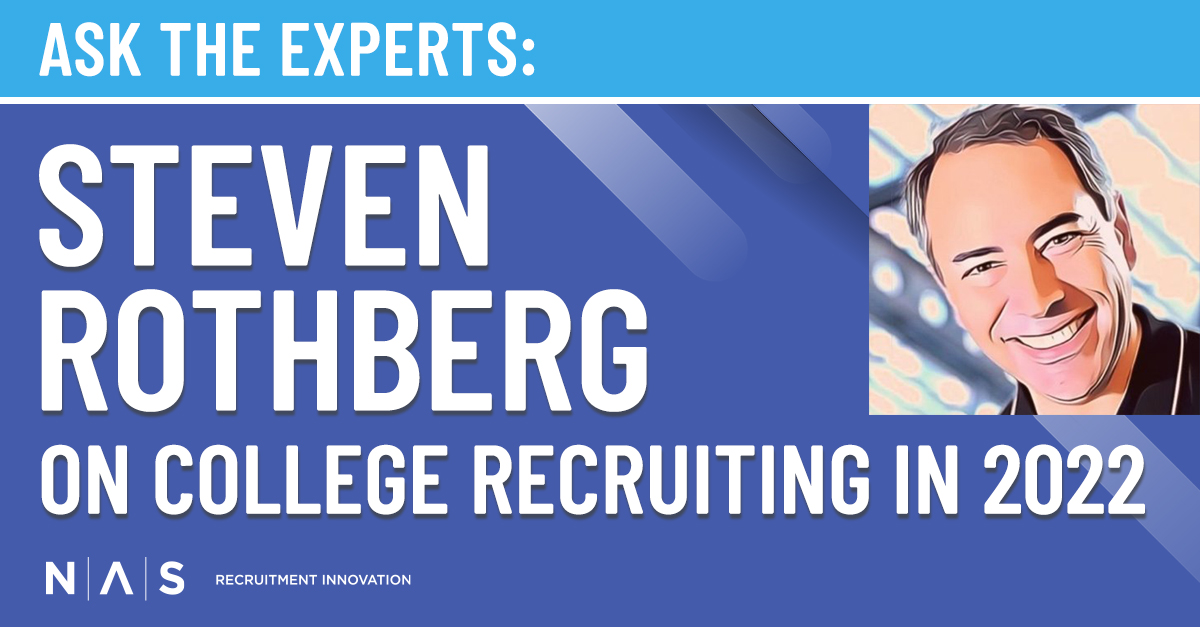-
Ask the Experts: Steven Rothberg on College Recruiting in 2022
Posted by Jennifer R. Henley, PHR & SHRM-CP | Chief Customer Officer on October 13th, 2022 
In celebration of NAS’ 75-year anniversary, we wanted to bring something new to the blog. We decided to go outside of our organization and ask the experts in recruiting about their strategies, perspectives and personal experiences. Today, we are hearing from Steven Rothberg, the Chief Visionary Officer and Founder of College Recruiter.
College Recruiter believes that every student and recent graduate deserves a great career. Its customers are Fortune 1,000 companies, government agencies and other employers hiring at scale who advertise their part-time, seasonal, internship and other entry-level jobs. Each year, their platform helps 12 million candidates find early career opportunities. Here’s what we asked the expert:
What are some of the most important “wants” for college students who are about to enter the job market in 2022 and beyond? What are they looking for from their first post-college employer?
As is the case with most candidates, what they want is quite different depending on what stage they’re at in the job searching process. If they’re just applying to jobs and not weighing one against the other, job title, geographic location and compensation are far more important than any other factors. Once they’ve applied, they then start to care about other factors such as opportunities for advancement, mission of the organization, employer brand, etc.
Employers who want to cut their recruitment advertising cost by 25 to 50 percent and end up with a higher quality applicant pool should use job titles that are the same as those used by their likely applicants when they’re searching for jobs at job boards. Also, clearly indicate the location, if the job is hybrid, remote or work-from-anywhere and display the compensation range for the role.
How important is it for companies to showcase their DE&I initiatives to college students today?
Employers should be transparent about their DE&I initiatives. Own your failures, address what you’re doing to remedy them and promote your successes. If your C-suite was 10 percent female five years ago and is now 30 percent, share that and tell them that you’ve made huge strides, but your goal is for your C-suite to be at least 50 percent female by 2025, or whatever may be the case.
Candidates of all generations, but especially the Zoomers, who comprise the bulk of college and university students, no longer work to survive or even to have a decent lifestyle. In this labor market, both of those are now assumed. It isn’t enough to offer a paycheck in return for work the employee is qualified to do. They want and deserve purpose, and an organization that can demonstrate that it is committed to DE&I is far more likely to be able to allow the employee to achieve that purpose.
Should companies concentrate on Fall and Spring to recruit college students, or do they need a year-round strategy?
It has never been the case that students only search for jobs in the Fall and Spring. That was always the schedule for the convenience of the career service offices and, to a lesser extent, the employers. But you don’t need to physically go to college campuses to hire all the high-quality students you want. That can be a part of the picture, but you can hire faster, better and cheaper online.
It’s important to recruit year-round. There’s no need to plan in May for your on-campus interviews in September and October and for people to start in May and June. If you have the hiring need in May or October, hire them. They’re looking even if career services would prefer otherwise.
What are some of the components College Recruiter recommends as part of an effective strategy to recruit new grads?
The biggest differences that we see between employers who are feasting and those who are starving in this labor market is that the former have earned a reputation for both treating and paying their employees well, while those who are struggling tend to have a long history of both treating and paying their employees poorly. Trust and, therefore, attraction need to be earned and authentically communicated.
If you have a history of treating or paying your employees poorly, own that and point to concrete, specific actions you’ve taken to remedy the situation, even if you just started that journey. For example, you can say that you’ve increased average hourly pay over the past three years from $10 to $15 and have as a goal for that to be $20 an hour by 2025.
How does a company maximize its on-campus presence and engage students seeking careers post-graduation?
Maximizing an on-campus presence does little to nothing to engage students who are seeking careers post-graduation because they’re no longer on-campus. If you want to reach recent graduates, you’re going to fail if you try to do so through their schools, because the day they graduate is often the day they stop using their career service offices.
Beyond traditional on-campus visits, are there digital and social strategies that can be effective?
Until Covid forced employers to stop traveling to college campuses, most students were hired pretty much the same way candidates were hired in 1952. For the most digitally connected segment of the population, the tactics and strategies were the least digitally aligned. Employers were running analog campaigns in a digital age. Covid forced them to experiment, and they found that they could hire within weeks of the requisition date instead of a year or more, and they could hire a far more diverse group of candidates. Also, they could do all of that at about 10 percent of the cost because advertising online is minimal and there are no travel costs.
There are several excellent resources for reaching students and recent graduates, each with its strengths and weaknesses. At College Recruiter, we believe that every student and recent graduate deserves a great career, so our site has always been built to be inclusive and not exclude candidates from seeing your posting, or otherwise be excluded from your hiring process, simply because of what school they happen to attend or graduate. But if you’re only willing to consider currently enrolled students from a small number of schools, post those jobs directly to their websites of the career service offices. If you do, you’re likely posting through career service office management platforms such as Handshake, Symplicity or Gradleaders.
Do you recommend staying in touch with students during their education? How can a company develop a pipeline over time?
Sponsoring student organizations, even buying pizza for their monthly meetings, is an incredibly powerful way of connecting with students and building a pipeline that will extend past the student organization and to the friends and family members of those in the organization. In addition, consider being a guest lecturer. Most professors welcome non-pitchy guest lecturers.
Don’t come into the classroom expecting to tell the students why they should work for your organization. Instead, tell them about your experience with the subject matter they’re learning, and allow them to see for themselves that you and your organization are subject matter experts. If they do, the best of the students will seek you out because the best typically want to work with the best.
What is the one key insight you have for companies who are actively recruiting college students?
Today, most organizations are struggling primarily with attracting enough applicants. The conversion rate from applicant to interview, offer and hire hasn’t changed much. So, if you’re struggling to hire, it is likely a problem with not enough candidates converting into applicants, which is right at the top of the funnel. The solution is relatively easy to fix: Make sure your job titles are the same as those used by candidates, promote hybrid or remote or work-from-anywhere policies if they’re applicable and display your compensation ranges. Just those changes will likely increase the percentage who apply by two to four times.
Thank you so much to Steven Rothberg for providing us with his expert advice and being the inaugural interview for our new Ask the Experts section. We will continue to bring you more great information on recruiting from some of the best in the biz. Check back soon!
Jennifer R. Henley, PHR & SHRM-CP | Chief Customer Officer
Jennifer Henley is a trusted authority in recruitment solutions and consultative client services. She possesses the Professional in Human Resources (PHR) and SHRM-CP designations, is a proud member of MAHCR, NAHCR and SHRM, and is a featured speaker at HR communications industry conferences and events nationwide.



